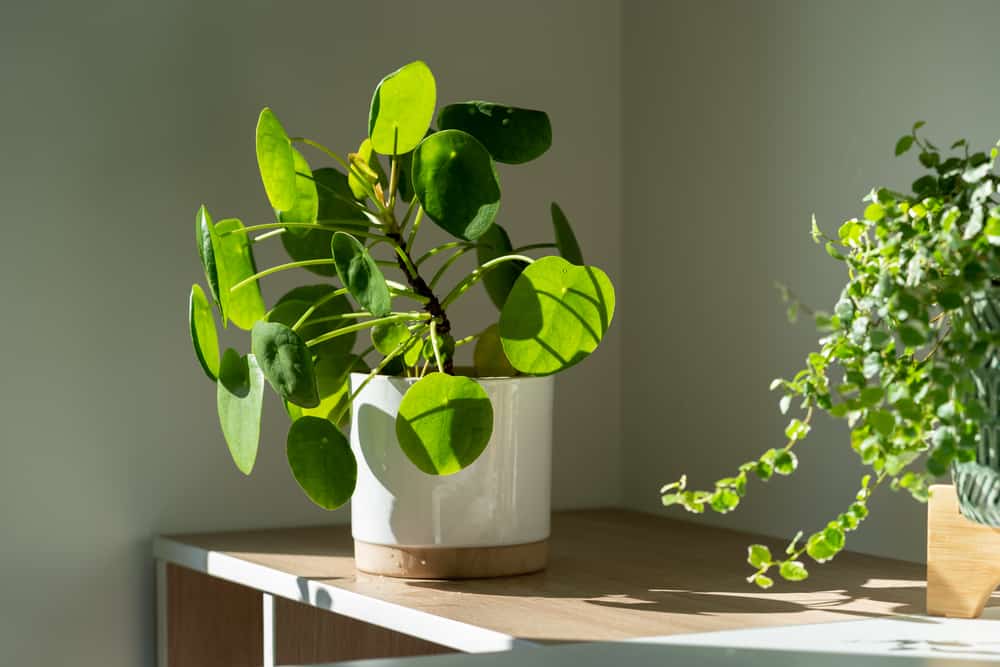Featured
Chinese money plants are great. Not only are they cutely photogenic, but they are also simple to care for and incredibly easy to propagate. So you can keep adding to your collection or make plant parents of your friends and family by sharing baby plants with them!
Check more of these plants online.
About the Chinese Money Plant
Chinese money plants (Pilea peperomioides) have soared in popularity over the last few years and it isn’t difficult to see why.
Succulent-like stems and large, rich green leaves provide a minimalist, contemporary look that is perfectly suited to any room in the house. On top of that, the Chinese money plant is a low-maintenance houseplant that doesn’t take much expertise to look after.
As you’d imagine, Pilea plants are native to the Yunnan region of Southern China. The name money plant comes from the way the leaves often overlap each other, looking like a pile of coins. Pilea plants are also said to bring good luck and fortune to their owners – making them an ideal gift for housewarmings and engagements!


In fact, these plants have many common names:
- Pancake plant: This name is derived from the large, flat, round leaves.
- UFO plant: Again, because of the rounded shape of the foliage.
- Missionary plant: Pilea peperomioides was first brought to Europe by a Swedish missionary in the early 20th century.
- Pass-it on plant: This name refers to how easy Pilea is to propagate and pass on to friends and family.
Why You Should Propagate Pilea Peperomioides
Creating a baby plant from stem or leaf cuttings is a satisfying way to extend your collection of house plants. Starting a plant off and nurturing it from a cutting to maturity is gratifying and your efforts are handsomely rewarded with a gorgeous new plant for free.
Propagating a Chinese money plant is relatively simple and lets you successfully expand your collection of house plants.
When to Propagate Chinese Money Plants
Propagating Pilea peperomioides can be done at any time of year but spring is the ideal period for Chinese money plant propagation. March to June is when the plant grows fastest and you’ll see the quickest results.
Taking Cuttings from a Chinese Money Plant
Taking single leaf or main stem cuttings from a Pilea plant is really quite simple and easy to do.
Gather Your Tools
Before you start, it pays to have everything you need laid out and ready to use.
- Gardening gloves.
- Secateurs or a sharp non-serrated knife.
- A glass filled with water (only if you’re using the water method). Leave the water out for around 24 hours before use.
- A plant pot (if you plan to propagate Pilea peperomioides straight into the soil.)
- A quality well-draining potting soil.

How to Start Chinese Money Plant Propagation with a Cutting
The most important thing you need to know when taking a Chinese money plant cutting is where exactly to cut. Whether you choose to create new plants from stem cuttings or leaf cuttings will largely depend on the parent plant and the stage it is at.
Plantlets
During the growing season, many Chinese money plants will produce plantlets, also known as offsets, pups or babies. These offsets sprout from the soil and begin to grow alongside the mother plant. Just like human babies, plant pups need time to gain nourishment from the mother plant before being propagated and moved into a pot of their own. Don’t be too impatient, and give them plenty of time to get ready. Otherwise, it’s likely they won’t thrive when it is removed from the parent plant.
Once the pup has a few thumbnail-sized leaves, it’s likely to be ready to move out of its mother’s pot and flourish on its own. Brush away some soil towards the base of the stem and feel under the soil to get as much of the stem as possible. Using secateurs or a sharp knife, cut the offset as far down as possible.
Offsets are designed to grow into new plants, making this the easiest and usually most successful Chinese money plant propagation method.
Leaf Cutting
It is possible to propagate pass-it-on plants from leaf cuttings, but only with long-stemmed leaves. Use a sharp knife to take the single leaf cutting from the parent plant. Cut as close as possible to the base of the leaf’s stalk, and try to take a small nick from the mother plant’s main stem.
Once rooted, it’s not uncommon for the original leaf to die back. As long as there is new growth to take over, this isn’t a problem.
It’s worth noting that Chinese money plant propagation by leaf cutting is more prone to failure than using stem cuttings. However, if you have a dropped leaf or are too impatient to wait for offsets, there is no harm in giving it a go. Your plant cutting may well successfully grow roots and flourish.

Rooting a Chinese Money Plant Cutting
For plant propagation to be successful, the new plant needs to develop roots. There are two ways to root healthy leaf cuttings and stem plantlets – in water or in soil.
Whichever method you choose, keep the new plant in a bright spot out of direct sunlight and keep an eye on water levels to ensure easy access to moisture.
Root in Water
Rooting Chinese money plants in water is the easiest way to grow roots and the most likely to be successful.
Fill a glass with water and pop the cutting in it, ensuring only the stem is submerged and the leaves stay dry. If the leaves get wet, they will rot. Tap water is fine but leave it out for a day or so before use. Doing this allows any chemicals to dissipate and give the water a chance to reach room temperature.
Visible roots should start to appear after around 10 days, but be patient as it could take up to 3-4 weeks. When the roots reach 1-2 inches long, the plant is ready to be transplanted into a pot.
Root in Soil
If you’d prefer to skip the water step, it is possible to root healthy cuttings and pups straight into the soil. However, it is a bit trickier to pull off. You can’t see exactly how well the roots are coming along as they are hidden underneath the soil.
Rooting directly into the soil is more likely to work with pups than with stem cuttings. This is especially true if you are able to get some of the plantlet’s roots when you remove it from the original soil.
The key to successful soil propagation is choosing the right potting mix. For Pileas, this needs to be in a well-draining soil that retains just the right amount of moisture. Too much and the plant will rot, while too little won’t allow roots to grow.
If the plant has been successfully rooted in the soil, new leaves will begin to appear within a few weeks. You may wish to use a rooting hormone to help speed things along.
Propagate When Chinese Money Plants Are Leggy
A leggy Pilea has a tall plant stem with a few leaves on top and none towards the bottom of the plant. This isn’t a great look for a Chinese money plant and it can be almost impossible to encourage new leaf growth on the lower half of the stem.
However, the good news is that you can simply cut the top off the plant to promote healthy leaf growth all the way up the stem. Called ‘topping’ the plant, main stem propagation involves cutting the mother plant’s stem in half. New growth will soon appear and the plant will have a fuller bushier look to it.
Topping is also one of the most effective Pilea peperomioides propagation methods. The plant cutting can be rooted in water and then moved to a pot, turning one unattractive plant into 2 healthy ones.

Does Chinese Money Plant Propagation Work Best In Water Or Soil?
While either method can be successful, most indoor gardeners would recommend rooting a missionary plant in water.
Rooting leaf and stem cuttings in water is much easier than in soil, and you can monitor progress through the glass. Even if the stem cutting has been dipped in a rooting hormone before planting, the composition of a potting mix has to be too exact for a leaf or stem cutting to root and grow into a healthy plant.
Rooting in water rather than a soil or potting mix is much more likely to result in a happy and healthy plant that can be added to your indoor jungle.
Pot Requirements
Baby Pilea plants need the right size of pot. Choose one that is too large and the soil will retain too much water and risk rotting the roots, but choose a too-small pot and new root growth will be curtailed. A small, shallow container is ideal for Pilea babies.
UFO plants will do just fine in plastic pots. However, if you’d like to give yours an extra little boost, choose a terracotta pot. The unglazed clay doesn’t hold water and lets plant roots breathe more easily. As it’s much easier to kill a Chinese money plant by overwatering than underwatering, a terracotta pot helps a baby plant develop its own root system with less risk of succumbing to root rot.
The Chinese money plant doesn’t like being repotted too often so choose a pot that affords some space for root growth. Aim to re-pot the plant once every 2-3 years into a pot that is 2 inches bigger than the previous one.
Soil Conditions
The ideal soil for Pilea plant propagation lets in plenty of oxygen for the root system to breathe, drains well while leaving the soil moist, and is bursting with nutrients for healthy growth.
If you have a tendency to overwater plants you may wish to add perlite or gravel to create a well-draining soil mix for your Chinese money plant.
Use a chopstick or lollipop stick to aerate the soil once a month. Simply poke it into the soil and move it around in a circular motion before watering. Doing this will improve airflow and drainage, as well has helping to prevent root rot.
Change the soil once every 1-2 years. Soil doesn’t retain its valuable nutrients forever, so changing it out for fresh soil helps plants get as much nourishment as possible from the potting mix.

Care After Propagation
Once your new Chinese money plant is settled into a pot, it’s time to nurture it to promote healthy growth. Just like humans, baby plants need some TLC to grow from a tiny plant into a mature plant that may one day become a parent plant itself.
Light and Water
The key elements to Chinese money plant care are light and water. Keep the new plant in bright indirect light and water regularly for consistently moist soil. Water from the top and ensure excess water escapes through the pot’s drainage holes before putting it back on the shelf. In just a few weeks you’ll notice plenty of fresh new growth as the new root system develops.
As the plant matures, the watering schedule can be relaxed somewhat, with the plant only needing to be watered when the top layer of soil feels dry. Keep the plant in a bright spot out of direct sunlight to prevent leaf scorch.
Temperature
Chinese money plants thrive in normal household temperatures. It’s best to keep the plant away from draughts and heat sources, but as long as the room stays between 15-30ºC the plant will be happy.
Misting
Missionary plants don’t have any specific requirements for high humidity but they don’t object to an occasional misting. As well as offering additional moisture and keeping the foliage hydrated, misting helps keep the large leaves free of dust, which is great for photosynthesis.
Rotation
Rotating the plant every few days will help promote even growth. Plants usually grow towards the light source, so by turning your UFO plant often, it’ll grow to look fuller and bushier. Without rotation, it is likely that all the leaves will grow outwards in the same direction.

Common Problems After Pilea Propagation
While Chinese money plant propagation is relatively straightforward, there are a few problems you may run into after the cuttings have settled into their new homes.
Curling Leaves
Chinese money plant leaves are supposed to be as flat as a pancake (remember they are often called pancake plants?) so if they start curling, you know there is an issue.
The most common reason for curling leaves is that the plant isn’t getting enough light or is getting too much light. The easy solution to this problem is to move the plant to a position where it can soak up plenty of bright, indirect sunlight.
You may find the perfect spot in summer provides less bright light in winter and vice versa, so experiment and find a new spot with the seasons. Just be careful to keep Pileas out of strong direct sun.
Droopy Leaves
Older leaves may start to droop a little as they become too heavy for the stems. If these make the plant look unsightly, there’s absolutely no harm in cutting them away from the main plant stem.
However, if a few leaves look droopy and it’s not just the older ones that are affected, the issue might be your watering schedule. Both over-watering and under-watering can result in droopy leaves, so take a look and feel of the soil and consider how often the plant has been watered. You should be able to tell if the plant needs to be watered more often or the soil left to dry out a bit more between waterings.
Brown Leaves
Crispy brown leaves are almost always a sign that a Chinese money plant is getting too much direct sunlight. The easiest way to remedy the issue is to move it away from the window, where it can bask in bright indirect light.
However, browning leaves can also be caused by fertiliser burn. If this is the case, simply hold off fertilising the plant for a few weeks and use a less concentrated solution for future feeds.
Yellow Leaves
Again, one or two older leaves turning yellow isn’t anything to worry about. But if you start to notice younger leaves adopting a yellow tone, it’s likely there is an issue with over-watering.
Ensure the pot’s drainage holes aren’t blocked and that the soil isn’t too heavy. If necessary, change the plant’s soil and add some coarse sand to the regular potting soil to assist drainage. Remove any yellow leaves and feed the plant using a quality house plant fertiliser.
Taking cuttings from pancake plants is relatively simple. As long as you use a clean cutting tool, place it in a bright spot away from direct sun, and keep the roots moist (but well-drained if in soil), it is difficult to go wrong.
Chinese money plants are ideal for propagating without much hassle. If you fancy having a go at propagating your own low-maintenance plants and watching them thrive, these are the perfect plants to begin your journey with. After all, who could resist having more than one of these striking little beauties in the home?





























